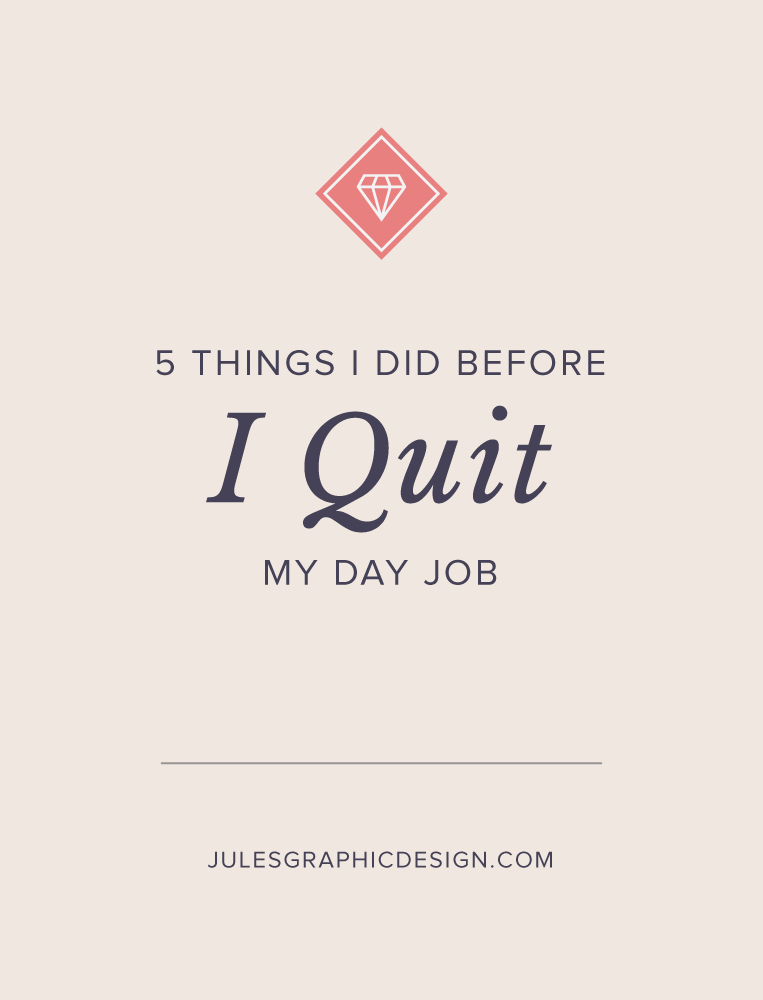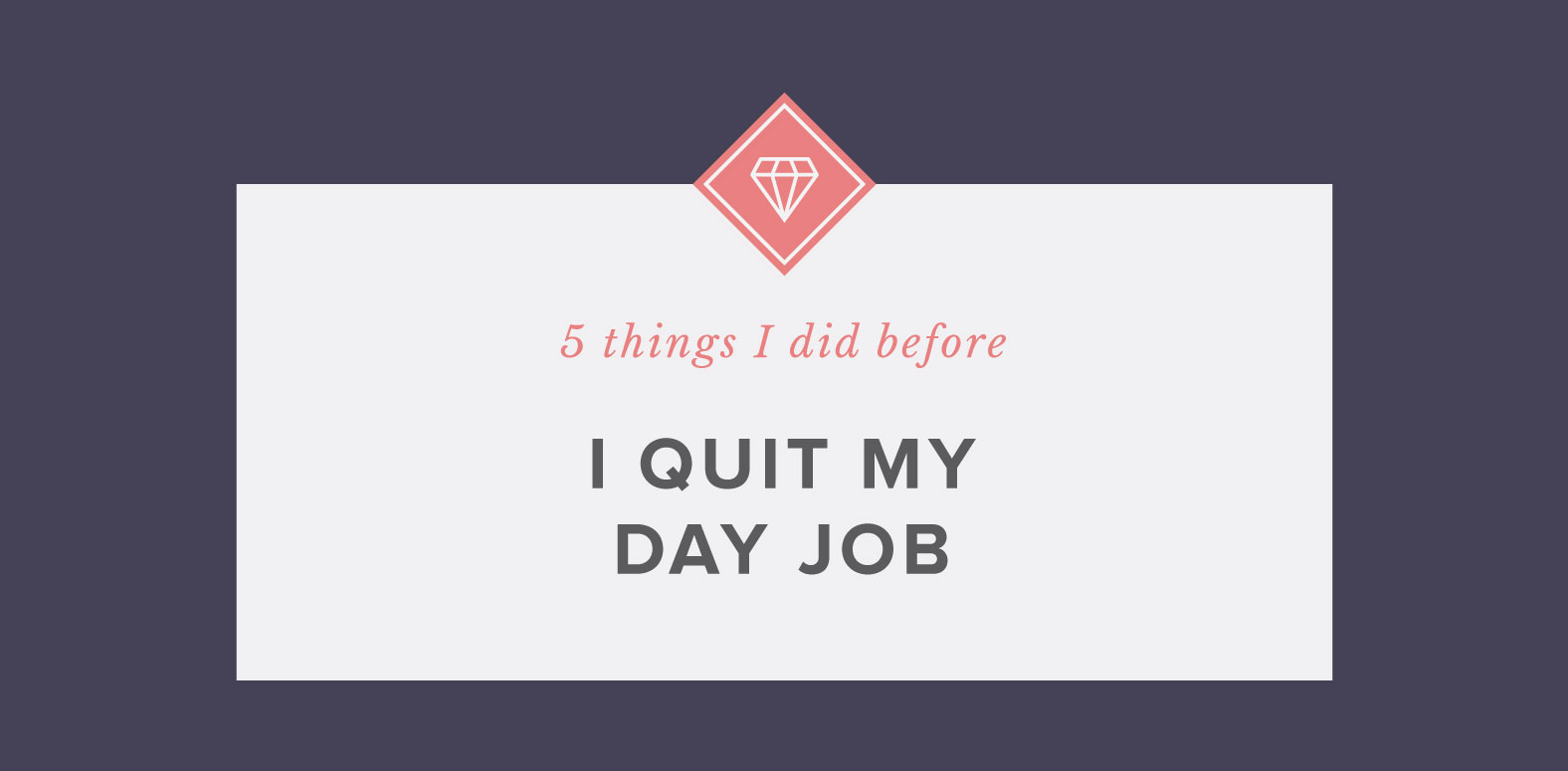50% OFF the entire shop through Cyber Monday! Use Code: BLACKFRIDAY50
Black Friday Sale
Starting your own business is a lot of work. If it’s something you’re really passionate about though, then its definitely worth it! I went from working for myself to a full-time design job, and back to freelancing, all within a 5 year time period. For me, nothing beat being my own boss and having the flexibility to work the hours that I choose. I finally took the leap into full-time entrepreneurship and I’m not turning back this time around. If you’re interested in working for yourself then keep reading to discover the 5 things that I did before quitting my day job.

I Did the Math
The first thing I did before transitioning from side hustle to full-time entrepreneur was to figure out my desired income. This income decision is very important because it drives everything from how much you should charge for your services to how many clients you need to work with each month. It can seem a little daunting at first, but I promise that it’s worth the effort, to do the math and calculate what you want to earn.
I started by adding up all of my necessary personal and business expenses to see how much I HAD to make each month to stay in business. This included non-negotiable expenses like Adobe Creative Cloud (for my business) and my Mortgage (for my personal expenses). I added up all of these expenses and came up with a monthly and yearly total for how much I needed to make.
Now, this number doesn’t take into account lifestyle expenses, which, are things that aren’t necessarily a requirement but are things that I enjoy doing each month. These expenses included things like my barre classes, going out to dinner a few times each month, vacations and gifts. I added my two totals together and had a monthly and yearly number that was more in line with what my salary should be.
Now that I had a monthly and yearly salary in mind, I was able to calculate what my starting flat rate pricing should be for my branding, website, and print design packages. I also came up with an hourly rate based on these numbers. Lastly, I did the math to decide how many clients I would need to work with per month to make my income goals. Just a note, that this salary is just a starting point and should change throughout your career. I plan to go through this entire process again and reassess my numbers before 2018.
I Saved Up
I promise that this entire article is not going to be about finances, but it’s definitely an important aspect of starting a business. A lot of financial experts will recommend that you save 6-12 months of your income before making your side hustle your full-time gig. I already had a business checking and savings account in place, so I simply made it a point each month, to put some of my income from my day job into this savings account.
I didn’t quite listen to the experts but did save 3 months of income before taking the leap. I felt comfortable doing this, but I’m by no means telling you to do exactly what I did. I was able to leave my day job a little earlier because I was earning some income on the side and my husband has a salaried position. Everyone has a different level of comfortability with their finances, so please do what you think is best here.
Saving ahead of time is so important because it establishes a safety net for the first year that you’re in business. During your fist few months, you might find that you aren’t getting as my client inquiries as you would like, or you might have a slow month later on down the road. Having that savings in place, allows you to continue to pay yourself a consistent “paycheck,” even if one month is a little slower than another.
I Created an Office Space
Now onto a more fun aspect of starting your business! At least, I found that setting up my office was a lot of fun. It’s good to start separating home and work really early on. For instance, try to avoid working from your couch or bed as much as possible to prevent the blending of your two lives at home.
If you don’t already have a computer and Adobe Creative Cloud, make sure you save up for both of those things before quitting your day job. If you’re a graphic designer those should be your first purchases. You might also find that you need to purchase other supplies such as a printer, work phone, art supplies, or organizational bins.
Choose a designated place in your home to put your office space. For me, this is part of a spare bedroom, right next to a window (because I love natural light!). Make sure that you pick a space in your home that inspires you and is free from distractions. Before I quit my job, I organized my office space to set myself up for success. I did a little bit of decorating but still, have more work to do on this front. For instance, the space above my computer is blank and I want to fill it with inspirational artwork.
I Re-Branded Jules Design
As I mentioned in my last blog post, this is not my first time going out on my own. I decided to keep my business name, Jules Design but wanted to visually give my brand a new look that better represented the direction that my business was going. I designed my new brand identity, with my audience of creative female entrepreneurs in mind. After several revisions, I fell in love with this hand-lettered logo and feminine color palette. I also built out my brand identity with various patterns, iconography, and secondary logos. I took the time to create a branded proposal and media kit template so that when my first clients contacted me, I had these pieces ready to go.
I still need to create a website to match my new branding. I have incorporated elements into the current website but I want to design a new website that better encompasses all of the brandings that I worked so hard on. If you want to go that extra mile before taking the leap, it wouldn’t be a bad idea to completely re-brand everything, including your website, before quitting your day job. You should definitely have some kind of web presence though, even if its a themed website.
I Set-up a Project Management System
If you don’t already have a design process mapped out, that’s fine! But, I recommend spending some time really thinking about how you want to work with your clients. How many concepts do you plan to show them? How many revisions will they receive? What do you think is the best way to go about project managing everything? Work on developing a system that makes sense to you, but will ultimately provide your client with quality design and a simple streamlined process.
Personally, I absolutely love working with Asana as a project management tool! I find that it’s really easy for both me and my clients to use. During client onboarding, I invite them to join me in Asana, so that we can collaborate throughout the entire project. I set-up a to-do list that tells my clients exactly when they can expect to receive deliverables from me. It’s wonderful for assigning tasks to others and sending automatic reminders when a part of a project is due. Assignments, usually include things like client questionaries, feedback on my deliverables and copy/photos. I handle all of my client communication through Asana so that everything is organized and all in one place. I will walk through this process in more detail in a future post, but I’m still working on refining my process during my first few months.
Other Steps to Consider
Here are a few other helpful things to consider if you are thinking about going out on your own:
• Do you want to be a Sole Proprietor or LLC?
• Should you trademark your business name?
• Set up business banking accounts
• Get an EIN number
• Get a Business License
These were all things that I took care of the first time that I started my business, so they were already in place when I left my day job this time around. Although, I still need to switch from a Sole Proprietor to an LLC. More on that later though.
I wanted to wrap up on this note: Nobody has is all figured out when they first take the leap. I’m still learning as I go, and I love that I can share my struggles and successes with you, right here, on my blog.
I want to hear from you too! Have you taken the leap into full time freelancing? If so, what did you do to prepare?
You only get one homepage. Let’s make it work harder. Get a free expert review of your homepage, so it actually attracts your dream clients!
Free Homepage Health Check
Copyright 2022 - All Rights Reserved | Website made by Jules Design (of course!)
Terms & Conditions
Privacy Policy
We are a Richmond Virginia based website design and brand identity design studio for dietitians, nutritionists, health coaches, fitness professionals and wellness entrepreneurs. We love working with brands with compassion in the health space.
